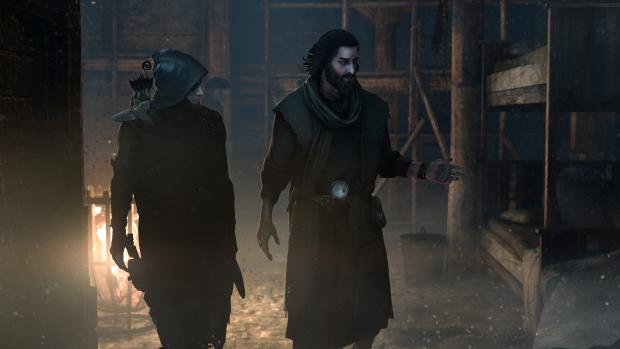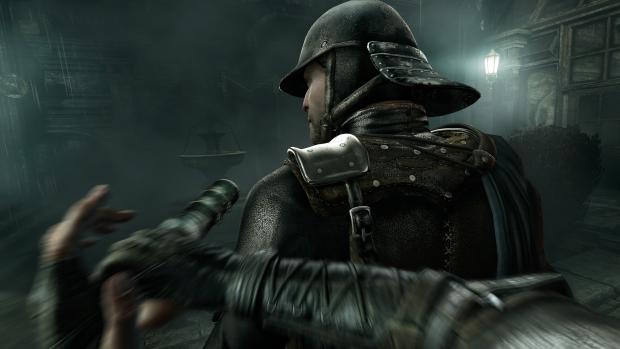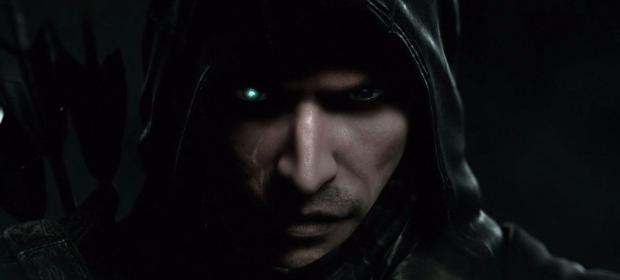You’re crouched in the shadow of an abandoned wagon, avoiding the flickering glare of the nearby streetlight. There’s a guard to your right, mumbling about the cold, two more to your left; chatting about their latest sordid adventures at the House of Blossoms as they do their rounds. All you have to do is make it across the street and you’re home free. Should be easy, with all the tricks at your disposal: you could use a water arrow to douse the brazier nearby and blanket the road in shadow; you could fire a rope arrow at an overhanging beam and use the rooftops to reach your goal. Hell, you could just make a run for it.
You make your choice, notch an arrow, take a breath and rise from the shadows – but then you catch a glimpse of something shiny and gold from the corner of your eye, and that changes everything. Because you’re Garrett the Master Thief, opportunist extraordinaire, magpie in a man’s clothing, and you never let a bauble go un-pilfered.
At least, that’s how the story of Thief begins. Within the first hour, Garrett’s simple existence starts to unravel, as he finds himself plunged into a shadowy, far-reaching conspiracy involving supernatural cults, a lethal disease, and an awful lot of backstabbing and pickpocketing. It’s not always surprising in the directions it takes, but the plot is gripping enough. The character of Garrett is lifted from the anti-hero playbook, but those who remember the original games will recall his “honour among thieves” attitude and his love of patience and efficiency. The supporting cast is a rogue’s gallery in the truest sense, from fellow thieves, back alley contractors, shifty fences and corrupt politicians, all attempting to use Garrett as a tool to enhance their own fortunes. It’s nothing we’ve not seen before, but the script is well-written and well-delivered, even if the juxtaposition of American accents with British regional dialects is as jarring here as it ever has been.

The world is presented in the first person, and you’re tasked to use Garrett’s agility and natural gifts to break into or out of a variety of establishments and misappropriate all that glitters. If you happen to crack a conspiracy and destabilise the despotic balance of power into the bargain, then all’s the better. Controlling the Thief is easy once you get the hang of it, though initially those used to free-running in other games might be a little perplexed. L2 is your run, jump and climb button, while Square takes care of contextual actions, R2 controls your throwing or bow arm, and R1 deploys Garrett’s trusty blackjack. Before long, navigation becomes second nature, and you’ll be leaping and dashing around The City and her dishevelled environs like you’ve lived there all your life.
In keeping with the series’ established lore, Garrett’s false eye is present, though it’s less steampunk this time round. You can still use it to zoom in for better targeting or to survey routes, but it feels less essential than it once did. Instead, you have Focus Mode, whereby a tap of Triangle highlights objects in the world such as trinkets, traps and means of access. It also slows time during combat, allowing you to dodge and counter easier. Garrett is tough, but guards are tougher, and the slightly under-developed combat means if you find yourself surrounded by thuggish watchmen you’re probably going down without some quick thinking and quicker fingers. It’s not always explicit when a blow connects, and a little more weight behind Garrett’s blows would have been welcome. Likewise, for some reason even broadhead arrows are rarely enough to drop a charging guard, meaning you’re often left with little option but to run and hide when you’re spotted. This is likely deliberate, as this game is about theft and stealth (and not murder and mayhem) but it’s still to the detriment of the immersion that an arrow in the face won’t knock a guy down.

In fact, the NPC behaviour in general is where Thief falls down more often than not. It’s a game built on the principles of planning, patience, and precision, yet it rarely calls for either of the three. Inconsistent rules are a blight throughout: why can you hurl some bottles to distract guards, but not others? Why can you scale some walls, or climb some obstacles, when others impede your progress? Guard behaviour never varies, either. There’s nothing dynamic or procedural – which is par for course, but easy to read. The guards themselves are automatons, repeating dialogue and actions, announcing loudly when they’re going to handily fall asleep, or occasionally standing like mannequins until their behavioural programming loops back round. One particular alley will usually contain a rabble rouser whose dialogue is clearly written for more than the single NPC stood in front of them, which is always slightly ludicrous. These things are annoying, but not game-breaking, especially when Thief conjures such a wonderfully oppressive atmosphere elsewhere.
You’re always in darkness and the light is your enemy. Candles can be snuffed, lights switched off, fires doused, and you can identify approaching watchmen by sound. As long as you’re shrouded in darkness and they’re not wielding torches, you’ll get by unscathed, but like all good stealth games, it’s often more fun when your plans go south. Luckily, Garrett is well-armed with a variety of arrows, flashbombs, and curatives, which can be accessed at the touch of a button. On PS4, you can use the touchpad to make inventory selection a cinch. Some caltrops and smoke bombs would have been handy, but what you have is more than fit for purpose. You can also buy trinkets to enhance your abilities, and tools such as a wrench and wire-clippers, so you can revisit previous areas and polish off the collectibles in Metroidvania style. You can spend as much time as you like in the central hub of The City, only entering focused missions when you choose to advance the story.

In addition to the physical stuff, Garrett’s natural abilities can be improved by buying Focus Points from the Queen of Beggars, a blind Granny Rags-style matron who preaches to the down and outs in a makeshift church. That you buy these upgrades with money rather than through earned XP is a little off-putting at first (especially as you need money to buy tools and gear), but since your only source of income is from stolen items and you use your skills to steal, it’s all relative. The focus upgrades only enhance, too, as Garrett is a badass from the start.
Every building you enter can be ransacked, every drawer and cupboard can be searched, most pockets can be picked. Your goal is to steal, steal, and steal some more. Picking locks is surprisingly easy, and searching paintings for secret switches is no more complicated than waiting for the pad to rumble and hitting the trigger, but it all feels incredibly satisfying – especially for the loot-fans out there. What Thief loses due to odd AI, it gains in the very act of theft, making you feel clever and almost ninja-like as you fill your pockets with other people’s gold.
Graphically, Thief is not the game that shows what next-gen can do. Impressive lighting and detailed environments are major boons, but the cutscenes have a strange grainy style, and suffer from stop-start animation that may or may not be deliberate, but which certainly isn’t all that impressive. It is, however, hugely atmospheric – a world of cloying shadows and dancing flames, of grit, grime and gristle that feels like a mesh of Sherlock Holmes’ London and Bill the Butcher’s New York City.
Longevity is added by a huge amount of collectibles, from trinkets and rare treasures to documents and newspapers, but if you fancy leaving the story behind for a while you can enter the challenge maps and test yourself against the world in online leaderboards. There’s an array of challenges (both timed and otherwise) that will test your skills and earn you bragging rights if you know how to use the shadows right.
VERDICT: With sharper AI and more considered NPC behaviour, Thief could have been a masterpiece. There are true flashes of brilliance, and they’re not rare, but they’re almost always offset by something that breaks the immersion or otherwise shakes the foundations of the game world. Not one of Thief’s flaws are a major problem, but together they rob this reboot of true greatness. Still, for fans of macabre stealth there’s nothing like it on PS4 or Xbox One, and despite a few issues, Thief does a solid job of satisfying the kleptomaniac within all of us.
 VERY GOOD. An 8/10 is only awarded to a game we consider truly worthy of your hard-earned cash. This game is only held back by a smattering of minor or middling issues and comes highly recommended.
VERY GOOD. An 8/10 is only awarded to a game we consider truly worthy of your hard-earned cash. This game is only held back by a smattering of minor or middling issues and comes highly recommended.
Review code provided by publisher.





